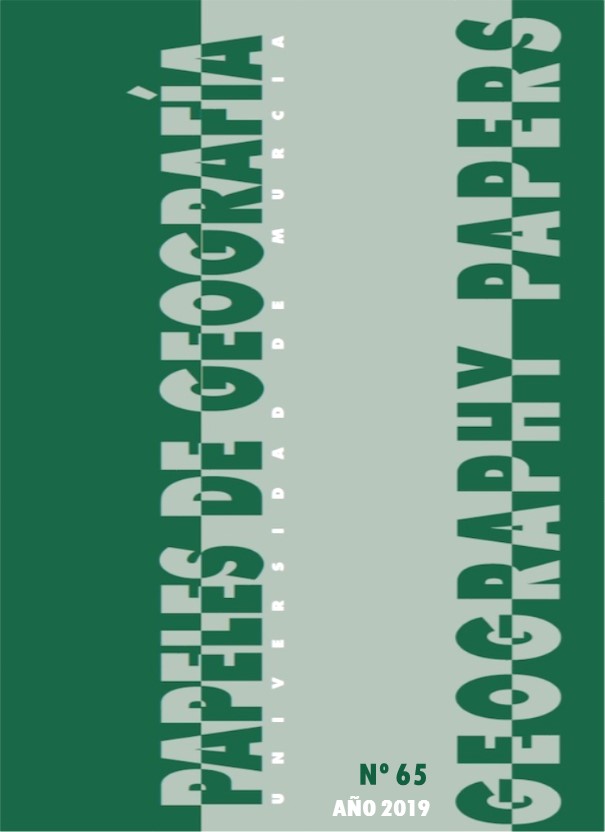Cuatro años después de la catástrofe, ¿Están los centros educacionales de la Región de Murcia en España preparados para el próximo desastre sísmico?
Resumen
Un terremoto de magnitud 6.0 o más está esperado en la falla Alhama de Murcia, la más activa de la región de Murcia, localizada en el sureste de España. El 11 de Mayo de 2011, en un intervalo de una hora y 42 minutos, dos terremotos de magnitud 4.5 y 5.1 sacuden las ciudades deLorca y Totana, resultando en nueve fatalidades y 330 heridos. Sin embargo, cuatro años después de la catástrofe, estas ciudades no parecen estar preparadas a hacer frente a un terremoto de magnitud moderada. Todos los factores están combinados para terminar en una catástrofe es decir, una superficie geomorfológica que favorece los efectos de sitio, construcciones que no cumplen con las normas parasísmicas y la falta de conocimiento sobre el riesgo sísmico por parte de la población. Este estudio propone unanálisis del nivel de vulnerabilidad de los centros educacionales contra el riesgo sísmico en Lorca y Totana basado en la creación de un índice de vulnerabilidad considerando los factores de riesgo sociales y estructurales. Además propone una serie de medidas de mitigación para hacer frenteal próximo desastre sísmico mayor.
Descargas
-
Resumen548
-
PDF339
Citas
BENITO OTERINO, B., RIVAS MEDINA, A., GASPAR-ESCRIBANO, J.M., MURPHY, P. (2012): El terremoto de Lorca (2011) en el contexto de la peligrosidad y el riesgo sísmico en Murcia. Física de la Tierra 24:255-287
BSSC (Building Seismic Safety Council) (2006): Earthquake-resistance requirements. In: FEMA 232, Homebuilders’ Guide to Earthquake Resistant Design and Construction, 2nd edition, Washington D.C. 21-48
CAPOTE, R., ESTÉVEZ, A., SANTANACH, P., SANZ DE GALDEANO, C., SIMÓN, J.L. (2011): ¿Dónde y por qué se producen terremotos en la península ibérica? Enseñanza de las Ciencias de la Tierra 19.3:317-328.
CERVERA, J. (2012): Dynamique des structures. Vulnérabilité aux bâtiments. Construction parasismique. Centre d’Innovation en Technologie pour le Développement Humain. Université Polytechnique de Madrid, 75 p.
GUHA-SAPIR, D., HOYOIS, P., WALLEMACQ, P., BELOW, R. (2016): Annual Disaster Statistical Review 2016. The numbers and trends. Centre for Research on the Epidemiology of Disasters (CRED), Institute of Health and Society (IRSS), Université catholique de Louvain, Brussels, Belgium
SALCEDO HERNÁNDEZ, J.C., CAMPESINO FERNÁNDEZ, A.J. (2012): Experiencias constructivas del terremoto de Lorca. Investigaciones geográficas 57:7-37
THOURET, J.C., D’ERCOLE, R. (1996): Vulnérabilité aux risques naturels en milieu urbain : effets, facteurs et réponses sociales. Cahiers des Sciences Humaines 96-2:407-422
VISSERS, R.L.M., MEIJNINGER, B.M.L. (2011): The 11 May 2011 earthquake at Lorca (SE Spain) viewed in a structural-tectonic context. Solid Earth 2:199-204
Las obras que se publican en esta revista están sujetas a los siguientes términos:
1. El Servicio de Publicaciones de la Universidad de Murcia (la editorial) conserva los derechos patrimoniales (copyright) de las obras publicadas, y favorece y permite la reutilización de las mismas bajo la licencia de uso indicada en el punto 2.
2. Las obras se publican en la edición electrónica de la revista bajo una licencia Creative Commons Reconocimiento-NoComercial 4.0 (texto legal). Se pueden copiar, usar, difundir, transmitir y exponer públicamente, siempre que: i) se cite la autoría y la fuente original de su publicación (revista, editorial y URL de la obra); ii) no se usen para fines comerciales; iii) se mencione la existencia y especificaciones de esta licencia de uso.
3. Condiciones de auto-archivo. Se permite y se anima a los autores a difundir electrónicamente las versiones pre-print (versión antes de ser evaluada) y/o post-print (versión evaluada y aceptada para su publicación) de sus obras antes de su publicación, ya que favorece su circulación y difusión más temprana y con ello un posible aumento en su citación y alcance entre la comunidad académica. Color RoMEO: verde.








